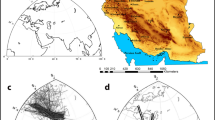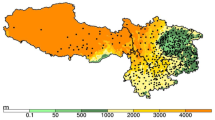Abstract
Most previous studies have investigated East Asian summer rainfall as one element. This study investigates the East Asian summer monsoon (EASM), Western North Pacific (WNP) tropical cyclones (TCs), and the concurrent rainfall occurring between May and September from 1983 to 2021. Three distinct types of rainfall are identified: monsoon-only rainfall, TC-only rainfall, and monsoon-TC joint rainfall (MS-TC rainfall), each exhibiting its own unique characteristics. Monsoon-only rainfall is characterized by positive anomalies along the East Asian subtropical front, while a decrease in TC activity leads to negative rainfall anomalies in the tropical WNP. TC-only rainfall, on the other hand, contributes to positive rainfall anomalies in the tropical WNP, as more TCs exhibit westward movement. In the case of MS-TC rainfall, positive precipitation anomalies are observed in the Philippines, the Korean Peninsula, and southern Japan. These anomalies can be attributed to an enhanced northward movement of TCs during such rainfall events. During strong monsoon-only (TC-only) rainfall years, the tropical western Pacific experiences anticyclonic (cyclonic) anomalies, along with a westward (eastward) shift of monsoon trough and WNP subtropical high (WNPSH). In strong MS-TC years, a localized cyclonic anomaly dominates the Philippine Basin, resulting in an eastward shift of the monsoon trough and WNPSH. Additionally, a significant increase (decrease) in vertical wind shear (VWS) is observed in the tropical WNP during strong monsoon-only (TC-only) years, while a moderate decrease is observed in strong MS-TC years. Distinct influential factors are associated with each rainfall type. Preceding positive sea surface temperature (SST) anomalies in the offshore China seas and WNP, in conjunction with the El Niño-Southern Oscillation (ENSO), play a primary role in driving interannual variations of monsoon-only rainfall. ENSO serves as the principal modulator of interannual variations in TC-only rainfall. Additionally, anomalous thermal conditions in the Maritime Continent (MC) act as major drivers for MS-TC rainfall. This study enhances our understanding of the underlying mechanisms and influential factors contributing to the diverse patterns of East Asian summer rainfall.















Similar content being viewed by others
Data availability
Several datasets are used in this study. The ECMWF ERA5 reanalysis data are available at https://cds.climate.copernicus.eu. The PERSIANN-CDR dataset is available at https://www.ncei.noaa.gov/products/climate-data-records/precipitation-persiann. TC track data is obtained from the IBTrACS provided by NOAA are available at https://www.ncei.noaa.gov/products/international-best-track-archive. ERSSTv5 and OLR data provided by NOAA are available at https://www.ncei.noaa.gov/products/extended-reconstructed-sst, https://psl.noaa.gov/data/gridded/data.olrcdr.interp.html, respectively.
References
Ashouri H, Hsu K-L, Sorooshian S et al (2015) PERSIANN-CDR daily precipitation climate data record from multisatellite observations for hydrological and climate studies. Bull Am Meteorol Soc 96:69. https://doi.org/10.1175/BAMS-D-13-00068.1
Bjerknes J (1969) Atmospheric teleconnections from the equatorial pacific. Mon Weather Rev 97:163–172. https://doi.org/10.1175/1520-0493(1969)097<0163:ATFTEP>2.3.CO;2
Chan JCL (2000) Tropical cyclone activity over the Western North Pacific associated with El Niño and La Niña events. J Clim 13:2960–2972. https://doi.org/10.1175/1520-0442(2000)013<2960:TCAOTW>2.0.CO;2
Chen J-M, Chen H-S (2011) Interdecadal variability of summer rainfall in Taiwan associated with tropical cyclones and monsoon. J Clim 24:5786–5798. https://doi.org/10.1175/2011JCLI4043.1
Chen J-M, Li T, Shih C-F (2010) Tropical cyclone- and monsoon-induced rainfall variability in Taiwan. J Clim 23:4107–4120. https://doi.org/10.1175/2010JCLI3355.1
Chen G, Sha W, Sawada M, Iwasaki T (2013) Influence of summer monsoon diurnal cycle on moisture transport and precipitation over eastern China. J Geophys Res-Atmos 118:3163–3177. https://doi.org/10.1002/jgrd.50337
Chen B-F, Lee C-S, Elsberry RL (2014) On tropical cyclone size and intensity changes associated with two types of long-lasting rainbands in monsoonal environments. Geophys Res Lett 41:2575–2581. https://doi.org/10.1002/2014GL059368
Chen J-M, Tan P-H, Wu L et al (2018) Interannual variability of summer Tropical Cyclone Rainfall in the western North Pacific depicted by CFSR and Associated large-scale processes and ISO modulations. J Clim 31:1771–1787. https://doi.org/10.1175/JCLI-D-16-0805.1
Cheng Z, Kang D, Chen L, Xu X (1999) Interaction between tropical cyclone and Meiyu front. Acta Meteorol Sin 13:35–46
Chiang JCH, Vimont DJ (2004) Analogous Pacific and Atlantic meridional modes of tropical atmosphere–ocean variability. J Clim 17:4143–4158. https://doi.org/10.1175/JCLI4953.1
Ding Q, Wang B (2005) Circumglobal teleconnection in the Northern Hemisphere summer. J Clim 18:3483–3505. https://doi.org/10.1175/JCLI3473.1
Ding R, Li J, Tseng Y et al (2015) The Victoria mode in the North Pacific linking extratropical sea level pressure variations to ENSO. J Geophys Res Atmos 120:27–45. https://doi.org/10.1002/2014JD022221
Gill A (1980) Some simple solutions for Heat-Induced Tropical circulation. Q J R Meteorol Soc 106:447–462. https://doi.org/10.1256/smsqj.44904
Hersbach H, Bell B, Berrisford P et al (2020) The ERA5 global reanalysis. QJR Meteorol Soc 146:1999–2049. https://doi.org/10.1002/qj.3803
Huang B, Thorne PW, Banzon VF et al (2017) Extended reconstructed sea surface temperature, version 5 (ERSSTv5): upgrades, validations, and intercomparisons. J Clim 30:8179–8205. https://doi.org/10.1175/JCLI-D-16-0836.1
Jiang Z, He J, Li J et al (2006) Northerly advancement characteristics of the east Asian summer monsoon with its interdecadal variations. Acta Geogr Sin 61:675–686
Knapp KR, Kruk MC, Levinson DH et al (2010) The International Best Track Archive for Climate Stewardship (IBTrACS): unifying tropical cyclone data. Bull Am Meteorol Soc 91:363–376. https://doi.org/10.1175/2009BAMS2755.1
Kubota H, Wang B (2009) How much do tropical cyclones affect seasonal and interannual rainfall variability over the Western North Pacific? J Clim 22:5495–5510. https://doi.org/10.1175/2009JCLI2646.1
Kurihara Y, Bender M, Ross R (1993) An initialization Scheme of hurricane models by vortex specification. Mon Weather Rev 121:2030–2045. https://doi.org/10.1175/1520-0493(1993)121%3c2030:AISOHM%3e2.0.CO;2
Li RCY, Zhou W (2013) Modulation of western North Pacific Tropical Cyclone activity by the ISO. Part I: genesis and intensity. J Clim 26:2904–2918. https://doi.org/10.1175/JCLI-D-12-00210.1
Liang B, Liang J, Wen Z (1995) Study of typhoon disasters and its affects in China. J Nat Disasters 4:84–91
Liebmann B, Smith CA (1996) Description of a complete (interpolated) outgoing longwave radiation dataset. Bull Am Meteorol Soc 77:1275–1277
Miao C, Ashouri H, Hsu K-L et al (2015) Evaluation of the PERSIANN-CDR daily rainfall estimates in capturing the behavior of extreme precipitation events over China. J Hydrometeorol 16:1387–1396. https://doi.org/10.1175/JHM-D-14-0174.1
Mo R (1988) The interannual fluctuations of rainfall and temperature over China and their correlation with El Nino. Acta Oceanol Sin 7:533–541
North G, Bell T, Cahalan R, Moeng F (1982) Sampling errors in the estimation of empirical orthogonal functions. Mon Weather Rev 110:699–706. https://doi.org/10.1175/1520-0493(1982)110%3c0699:SEITEO%3e2.0.CO;2
Rogers JC (1981) The North Pacific oscillation. J Climatol 1:39–57. https://doi.org/10.1002/joc.3370010106
Sun C, Xu X, Wang P et al (2022) The warming and wetting ecological environment changes over the Qinghai-Tibetan Plateau and the driving effect of the Asian summer Monsoon. J Trop Meteorol 28(1):95–108. https://doi.org/10.46267/j.1006-8775.2022.008
Teng H-F, Done JM, Kuo Y-H (2021) Landfalling tropical cyclone characteristics and their multi-timescale variability connected to monsoon and easterly formation environments over the western North Pacific. Q J R Meteorol Soc 147:2953–2977. https://doi.org/10.1002/qj.4108
Tu C, Huang S (1944) The advances and retreats of the summer monsoon in China. Acta Meteorol Sin 18:1–20
Wang B, Chan JCL (2002) How strong ENSO events affect tropical storm activity over the western North Pacific. J Clim 15:1643–1658. https://doi.org/10.1175/1520-0442(2002)015%3c1643:HSEEAT%3e2.0.CO;2
Wang J, Wu Z (2023) Distinctive features of Monsoon-TC Joint rainfall over Western North Pacific and its relationship with the Maritime Continent thermal condition. Atmos-Ocean. https://doi.org/10.1080/07055900.2023.2221217
Wang Z, Ding Y (2008) Climatic characteristic of rainy seasons in China. Chin J Atmos Sci 7:1–13
Wang B, Wu RG, Fu XH (2000) Pacific-East Asian teleconnection: how does ENSO affect east Asian Climate? J Clim 13:1517–1536. https://doi.org/10.1175/1520-0442(2000)013%3c1517:PEATHD%3e2.0.CO;2
Wang S-Y, L’Heureux M, Chia H-H (2012) ENSO prediction one year in advance using western North Pacific sea surface temperatures. Geophys Res Lett. https://doi.org/10.1029/2012GL050909
Wang B, Lee J-Y, **ang B (2015) Asian summer monsoon rainfall predictability: a predictable mode analysis. Clim Dyn 44:61–74. https://doi.org/10.1007/s00382-014-2218-1
Webster PJ, Yang S (1992) Monsoon and Enso: selectively interactive systems. Q J R Meteorol Soc 118:877–926. https://doi.org/10.1002/qj.49711850705
Wu Z, Jiang Z, He J (2006) The comparison analysis of flood and drought features among the first flood period in South China, Meiyu period in the Yangtze River and the Huaihe River valleys and rainy season in North China in the last 50 years. Chin J Atmos Sci 30:391–401
Wu Z, Wang B, Li J, ** F-F (2009) An empirical seasonal prediction model of the east Asian summer monsoon using ENSO and NAO. J Geophys Res-Atmos 114:D18120. https://doi.org/10.1029/2009JD011733
Wu Z, Li J, Jiang Z, Ma T (2012) Modulation of the Tibetan Plateau snow cover on the ENSO teleconnections: from the east Asian summer monsoon perspective. J Clim 25:2481–2489. https://doi.org/10.1175/JCLI-D-11-00135.1
**e S-P, Hu K, Hafner J et al (2009) Indian Ocean capacitor effect on Indo-Western Pacific climate during the summer following El Niño. J Clim 22:730–747. https://doi.org/10.1175/2008JCLI2544.1
**e S-P, Kosaka Y, Du Y et al (2016) Indo-Western Pacific ocean capacitor and coherent climate anomalies in post-ENSO summer: a review. Adv Atmos Sci 33:411–432. https://doi.org/10.1007/s00376-015-5192-6
Yuan S, Xu J, Chan JCL et al (2020) Resonance effect in Interaction between South Asian summer monsoon and ENSO during 1958–2018. J Trop Meteorol 26(2):137–149. https://doi.org/10.46267/j.1006-8775.2020.013
Zeng G, Wang W-C, Shen C (2012) Association of the rainy season precipitation with low-level meridional wind in the Yangtze River Valley and North China. J Clim 25:792–799. https://doi.org/10.1175/JCLI-D-10-05027.1
Zhang Y (1983) The heavy rainfall in China in 1980 and a comparison with earlier extremes. In: Street-Perrott A, Beran M, Ratcliffe R (eds) Variations in the global water budget. Springer Netherlands, Dordrecht, pp 253–264. https://doi.org/10.1007/978-94-009-6954-4_19
Zhang Y, Li Y, Bi M (1985) Abnormally heavy rainfall in the Changjiang Valley and its correlation with extraordinary oceanic features in 1983. Acta Oceanol Sin 4:535–547
Zhang Q, Gu X, Li J et al (2018) The impact of tropical cyclones on extreme precipitation over coastal and inland areas of China and its association to ENSO. J Clim 31:1865–1880. https://doi.org/10.1175/JCLI-D-17-0474.1
Funding
This research was jointly supported by National Natural Science Foundation of China (NSFC) Major Research Plan on West-Pacific Earth System Multi-spheric Interactions (Grant No. 92158203), the Ministry of Science and Technology of China (Grant No. 2023YFF0805100), and the Second Tibetan Plateau Scientific Expedition and Research (STEP) program (Grant No. 2019QZKK0102).
Author information
Authors and Affiliations
Contributions
J. Y. Wang designed the research under the supervision of Z. W. Wu. J. Y. Wang prepared figures and wrote the main manuscript. Z. W. Wu modified and reviewed the manuscript.
Corresponding author
Ethics declarations
Conflict of interest
The authors declare that they have no competing interests.
Additional information
Publisher’s Note
Springer Nature remains neutral with regard to jurisdictional claims in published maps and institutional affiliations.
Rights and permissions
Springer Nature or its licensor (e.g. a society or other partner) holds exclusive rights to this article under a publishing agreement with the author(s) or other rightsholder(s); author self-archiving of the accepted manuscript version of this article is solely governed by the terms of such publishing agreement and applicable law.
About this article
Cite this article
Wang, J., Wu, Z. Three types of East Asian summer rainfall associated with monsoon circulation and tropical cyclone activities: unique features and major influential factors. Clim Dyn 62, 4099–4116 (2024). https://doi.org/10.1007/s00382-024-07120-6
Received:
Accepted:
Published:
Issue Date:
DOI: https://doi.org/10.1007/s00382-024-07120-6




